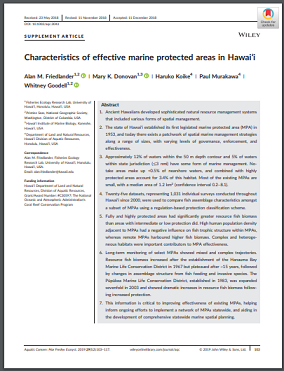
Ancient Hawaiians developed sophisticated natural resource management systems that included various forms of spatial management. The state of Hawaiʻi established its first legislated marine protected area (MPA) in 1953, and today there exists a patchwork of spatial marine management strategies along a range of sizes, with varying levels of governance, enforcement, and effectiveness. Approximately 12% of waters within the 50 m depth contour and 5% of waters within state jurisdiction (≤3 nmi) have some form of marine management. No‐ take areas make up <0.5% of nearshore waters, and combined with highly protected areas account for 3.4% of this habitat. Most of the existing MPAs are small, with a median area of 1.2 km2 (confidence interval 0.2–8.1). Twenty‐five datasets, representing 1,031 individual surveys conducted throughout Hawaiʻi since 2000, were used to compare fish assemblage characteristics amongst a subset of MPAs using a regulation‐based protection classification scheme. Fully and highly protected areas had significantly greater resource fish biomass than areas with intermediate or low protection did. High human population density adjacent to MPAs had a negative influence on fish trophic structure within MPAs, whereas remote MPAs harboured higher fish biomass. Complex and heterogeneous habitats were important contributors to MPA effectiveness. Long‐term monitoring of select MPAs showed mixed and complex trajectories. Resource fish biomass increased after the establishment of the Hanauma Bay Marine Life Conservation District in 1967 but plateaued after ~15 years, followed by changes in assemblage structure from fish feeding and invasive species. The Pūpūkea Marine Life Conservation District, established in 1983, was expanded sevenfold in 2003 and showed dramatic increases in resource fish biomass following increased protection. This information is critical to improving effectiveness of existing MPAs, helping inform ongoing efforts to implement a network of MPAs statewide, and aiding in the development of comprehensive statewide marine spatial planning.












